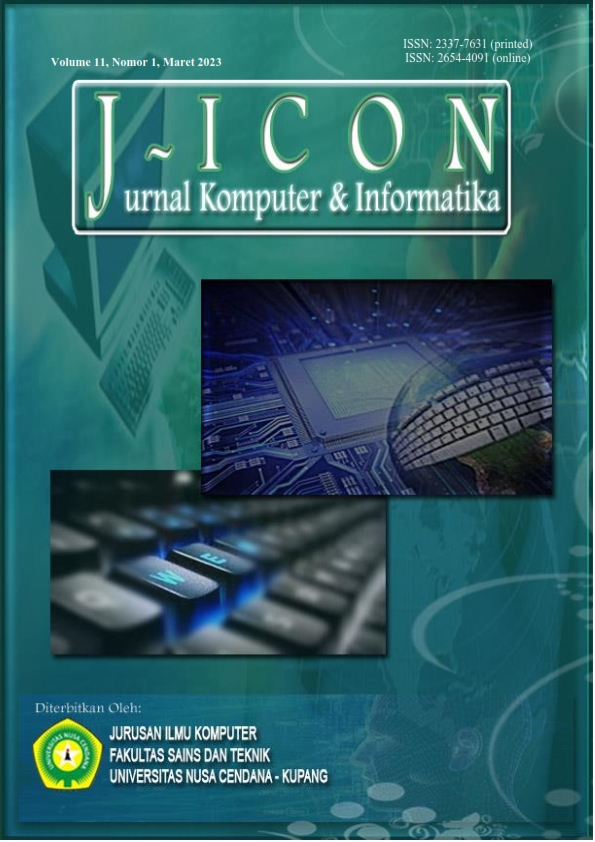DATA QUALITY MEASUREMENT TO IMPROVE SQA APPLICATION IN PT XYZ
Abstract
Service Quality Assurance (SQA) is one of a unit in PT XYZ an Indonesian e-commerce company. SQA is responsible for ensuring and maintaining services given to customers by Customer Service agents to meet the company's quality standard. However, the application was built without integration with the Customer Relationship Management (CRM) system, the main customer service application at PT XYZ. The problem is that if companies need SQA data, they must manually input data from SQA to CRM. This can cause vulnerabilities in the data input process. As a result, it impacts the company's business processes, which are inefficient and can be detrimental both materially and immaterially. This research aims to provide recommendations to improve the quality of SQA data so that companies can use the data to be integrated into the CRM system. The Total Data Quality Management (TDQM) method was used for this study with three dimensions: completeness, validity and accuracy. The results of each dimension are 99.64% for completeness, 84.75% for validity, and 100% for accuracy. Business rules on the validity dimension that have the lowest data quality are V1 28.57% and V6 65.11%. The problem factors were identified as an incomplete data dictionary, incomplete and obsolete SOP documents, and no business processes and data control on the application. Recommendations to improve the data quality of the application are PT XYZ can conduct an in-depth study of business roles so that all business processes can be clearly defined and regulations can be set forth in SOP documents. The use of specific reference data for each domain can be used to increase data legitimacy and the level of data suitability.
Downloads
References
C. Arthur, “Tech Giants May Be Huge, But Nothing Matches Big Data,” Technology, 2019. [Online]. Available: https://en.wikipedia.org/wiki/Clive_Humby#cite_note-10. [Accessed: 02-Mar-2023].
P. Woodall, A. Borek, and A. K. Parlikad, “Data quality assessment: The Hybrid Approach,” Information & Management, vol. 50, no. 7, 2013, doi: https://doi.org/10.1016/j.im.2013.05.009.
D. Loshin, “Business Impacts of Poor Data Quality,” Pract. Guid. to Data Qual. Improv., pp. 1–16, 2011, doi: https://doi.org/10.1016/b978-0-12-373717-5.00001-4.
A. Ohlsson, T. Leeke, J. Watson-MacDonell, and S. Forbes, “Data Quality Assessment for Perinatal Events in an Online Obstetrical Database (O-DB) and a Health Records Database (HR-DB),” Pediatr. Res., vol. 41, pp. 207–207, 1997, doi: https://doi.org/10.1203/00006450-199704001-01246.
L. English, “Information quality management: The next frontier,” DMReview Mag., p. 2, 2000, [Online]. Available: https://www.dmreview.com/article_sub_articleId_2073.html. [Accessed: 25-Mar-2023].
PT Bukalapak, “https://www.bukalapak.com/terms#introduction,” 2021. [Online]. Available: https://
www.bukalapak.com/terms#introduction. [Accessed: 25-Mar-2023].
W. Wijayanti, A. N. Hidayanto, N. Wilantika, I. R. Adawati, and S. B. Yudhoatmojo, “Data quality assessment on higher education: A case study of institute of statistics,” ISRITI, 2018, doi: https://doi.org/10.1109/ISRITI.2018.8864476.
W. A. Bowo, A. Suhanto, M. Naisuty, S. Ma’mun, A. N. Hidayanto, and I. C. Habsari, “Data Quality Assessment: A Case Study of PT JAS Using TDQM Framework,” ICIC, 2019, doi: https://doi.org/10.1109/ICIC47613.2019.8985896.
I. D. Andini, Y. Ruldeviyani, A. H. Maulana, and A. Hidayat, “Penilaian Kualitas Data Broadband Customer Profiling (BCP) Pelanggan Fixed Broadband PT Telekomunikasi Indonesia Tbk.,” Iptek-Kom, vol. 22, no. 1, 2020, [Online]. Available: https://202.89.117.136/index.php/
iptekkom/article/viewFile/2916/1361.
D. Plotkin, “Data Stewardship: An Actionable Guide to Effective Data Management and Data Governance”, 2014, doi: https://doi.org/10.1016/b978-0-12-410389-4.00007-6.
L. Jiang and J. Zhao, “An Empirical Study On Risk Data Quality Management,” ICIII 2012, vol. 1, pp. 511–514, 2012, doi: https://doi.org/10.1109/ICIII.2012.6339714.
M. Mosley, The DAMA Guide to The Data Management Body of Knowledge, First Edition, 2009.
M. Bertoni, “A case study on the analysis of the data quality of a large medical database,” DEXA, pp. 308–312, 2009, doi: https://doi.org/10.1109/DEXA.2009.82.
A. Esposito, Data Quality (Concepts, Methodologies and Techniques). 2006.
A. Lucas, “Corporate data quality management: From theory to practice,” 5th Iber. Conf. Inf. Syst. Technol., pp. 1–7, 2010, [Online]. Available: https://ieeexplore.ieee.org/stamp/stamp.jsp?tp=&
arnumber=5556606&isnumber=5556594. [Accessed: 25-Mar-2023].
C. Batini, C. Cappiello, C. Francalanci, and A. Maurino, “Methodologies for data quality assessment and improvement,” ACM Comput. Surv., vol. 41, no. 3, 2009, doi: https://doi.org/
1145/1541880.1541883.
R. Vaziri, M. Mohsenzadeh, and J. Habibi, “TBDQ: A pragmatic task-based method to data quality assessment and improvement,” PLoS One, vol. 11, no. 5, 2016, doi: 10.1371/journal.pone.0154508.
M. Bovee, R. P. Srivastava, and B. Mak, “A conceptual framework and belief-function approach to assessing overall information quality,” Int. J. Intell. Syst., vol. 18, no. 1, 2003, doi: 10.1002/int.10074.
M. M. C. Francisco, S. N. Alves-Souza, E. G. L. Campos, and L. S. De Souza, “Total data quality management and total information quality management applied to costumer relationship management,” ACM Int. Conf. Proceeding Ser., 2017, doi: 10.1145/3149572.3149575.
I. Nurrohmah, M. Ayu, A. Dewi, and N. Sahadi, “Measuring the e-Government Maturity in Indonesia using the Ranking of e-Government of Indonesia (PeGI),” ASRJETS, vol. 32, no. 1, pp. 49–63, 2017. [Online]. Available: https://core.ac.uk/reader/235050280. [Accessed: 25-Mar-2023].
L. Peer, A. Green, and E. Stephenson, “Committing to Data Quality Review,” Int. J. Digit. Curation, Vol. 9, No. 1, pp. 263–291, 2014, doi: 10.2218/ijdc.v9i1.317.
S. Riyanto, E. Marlina, H. Subagyo, H. Triasih, and A. Yaman, “Metode Penilaian Kualitas Data Sebagai Rekomendasi Sistem Repositori Ilmiah Nasional,” BACA, Vol. 41, No. 1, 2020, doi: 10.14203/j.baca.v41i1.544.
Copyright (c) 2023 Ratna Yulika Go, Rahmi Julianasari, Ahmad Syaifulloh Imron, Yova Ruldeviyani

This work is licensed under a Creative Commons Attribution 4.0 International License.
The author submitting the manuscript must understand and agree that if accepted for publication, authors retain copyright and grant the journal right of first publication with the work simultaneously licensed under a Creative Commons Attribution (CC-BY) 4.0 License that allows others to share the work with an acknowledgment of the work’s authorship and initial publication in this journal.
 Ratna Yulika Go(1*)
Ratna Yulika Go(1*)




